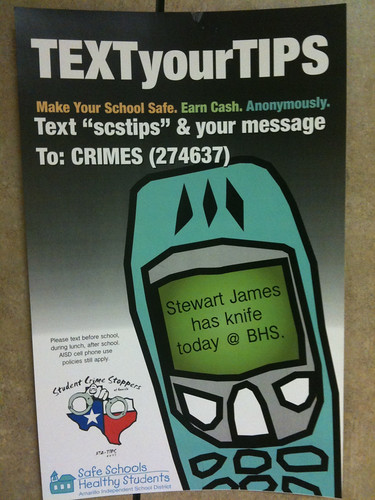The following poster is on display at Canyon High School in Canyon, Texas:
Students (and adults) are invited to use text messaging to alert the authorities about weapons at school or other criminal behavior. This project is sponsored by “Student Crime Stoppers of Amarillo.” The official organizational website explains how this works with text messaging:
Text “SCStips plus your message” to CRIMES (274637) Upon reception of a tipster’s first incoming message… The system will auto-reply with a confirmation containing their unique Tip ID. To submit follow-up information… The tipster simply replies.
Since a majority of secondary students (and an increasing number of elementary students as well) have cell phones in their pockets, programs like this which invite anonymous crime tips using SMS are a smart way to use technology devices at school. Since cell phone numbers are logged by the system, it’s not ENTIRELY anonymous, but it sounds like anonymity IS respected if that is the wish of the informant. The following cyber-etiquette suggestion is also included, however, since the schools which are served by Student Crime Stoppers of Amarillo have (apparently) differing cell phone use policies:
Please text before school, during lunch, after school. AISD cell phone use policies still apply.
A bunch of these schools do NOT appear to be in the Amarillo area, so I’m wondering if this is a service that any school in Texas can sign up to join?
The Amarillo Police Department website gives more information about how the service should be used. The important takeaway is: If you hear or see something suspicious, report it!
Students who step forward with anonymous tips leading to arrests will be eligible for cash awards through the program, based on an internally recognized model. [sic – should this be “internationally recognized?”]
School and police officials agree that most students want to do the right thing to keep their schools and neighborhoods safe but sometimes fear reprisals. The Student Crime Stoppers of Amarillo program offers the safety of complete anonymity while promoting responsibility and allowing students to take action against victimization and crime.
When to Call
- Maybe you overhear someone bragging about having committed a crime.
- Maybe you know someone who is driving a stolen car…or is hiding from the police…or is a robber or drug dealer.
- Or maybe you just see something that doesn’t look right. A strange car. A person acting sneaky. Someone with a gun or knife.
If you aren’t sure that what you saw or heard is really a crime, call anyway. Let the police decide if it’s worth investigating. It may be a piece of a clue to a big crime.
Consider this another “sign of the times” when it comes to technology in our schools: At least in the arena of crime prevention and law enforcement, more school leaders are recognizing the CONSTRUCTIVE roles which mobile technologies can play in the hands of students. Even at school.
Now if we could get more schools to unblock sites like iPadio for digital storytelling during and after school, we’d be making even MORE headway! See Liz Kolb‘s website, “From Toy to Tool: Cell Phones in Learning” as well as Tony Vincent‘s great “Learning in Hand” site for more ideas about how to constructively use mobile devices to support learning. Liz’ presentation for the 2007 K-12 Online Conference, “Cell Phones as Classroom Learning Tools” is still one of the best I’ve ever seen on this topic.
Is your school implementing a similar program to this one? If you have more information about the technology platform / system in use by Student Crime Stoppers of Amarillo or other, similar initiatives, please comment and share.
Technorati Tags:
cell, cellphone, mobile, phone, safe, school, sms, student, technology, texas, crime, stoppers, amarillo, prevention, safeschools
If you enjoyed this post and found it useful, subscribe to Wes’ free newsletter. Check out Wes’ video tutorial library, “Playing with Media.” Information about more ways to learn with Dr. Wesley Fryer are available on wesfryer.com/after.
On this day..
- Evaluating AllGirlArcade.com for my 11 Year Old Daughter – 2011
- Visualizing A Twitter Feed-based Digital Newspaper with Flipboard – 2010
- Empowering 21st Century Learners (Canyon ISD, Texas) – 2010
- Geography 2.0: A Juicy Way to Mash Up Learning – 2008
- Education, Learning and Media Megatrends – 2008
- Ecto 3 Alpha released, not recommended – 2007
- Real versus fake learning experiences – 2007
- Great list of open source software tools – 2006
- More cities and towns considering municipal wireless – 2006
- Great planet image – 2006



Comments
One response to “Using text messaging to prevent school violence (and other crimes)”
There is Absolutely No Way this is anonymous and that a “tipster’s” identity could easily be discovered.
Every teenager knows this.
They could have set up an anonymizer to route SMS traffic through. Or, they could use an anonymous WAP chat. That said, it’s pretty traceable, even then.
Trying to use cell phones for anonymous activities is nearly impossible. Ask Tiger Woods.